Abstract
The ability of beta-lactamase inhibitors to induce class I beta-lactamases in certain organisms in vitro suggests a potential for antagonism in vivo. Therefore, a study was designed to assess the ability of sulbactam and clavulanate to induce beta-lactamases in two strains each of Enterobacter cloacae, Citrobacter freundii, Serratia marcescens, and Pseudomonas aeruginosa both in vitro and in vivo. Induction in vitro was observed only with S. marcescens and P. aeruginosa and generally only when inhibitor concentrations greater than 2 micrograms/ml were examined. A mouse model of lethal infection, designed to detect in vivo antagonism arising from beta-lactamase induction, was used to determine what effect sulbactam and clavulanate would have on the 50% protective doses (PD50s) of cefoperazone and ticarcillin. Antagonism (a significant increase in the PD50) was observed in only 4 of 32 tests. Three of these involved antagonism of cefoperazone by clavulanate, and one involved antagonism of cefoperazone by sulbactam. In 6 of 32 tests, enhancement of efficacy (a significant decrease in PD50) was observed. In four of these, sulbactam enhanced cefoperazone; in one, sulbactam enhanced ticarcillin; and in one, clavulanate enhanced ticarcillin. Four of the six cases of enhancement occurred when the beta-lactamase inhibitor was given at the time of challenge. None of these positive or negative in vivo effects were predicted by in vitro tests. These data suggest that beta-lactamase inhibitors can influence the in vivo potency of their companion drug in both a beneficial and detrimental fashion against organisms with class I beta-lactamases and that these effects cannot be predicted from in vitro assays.
Full text
PDF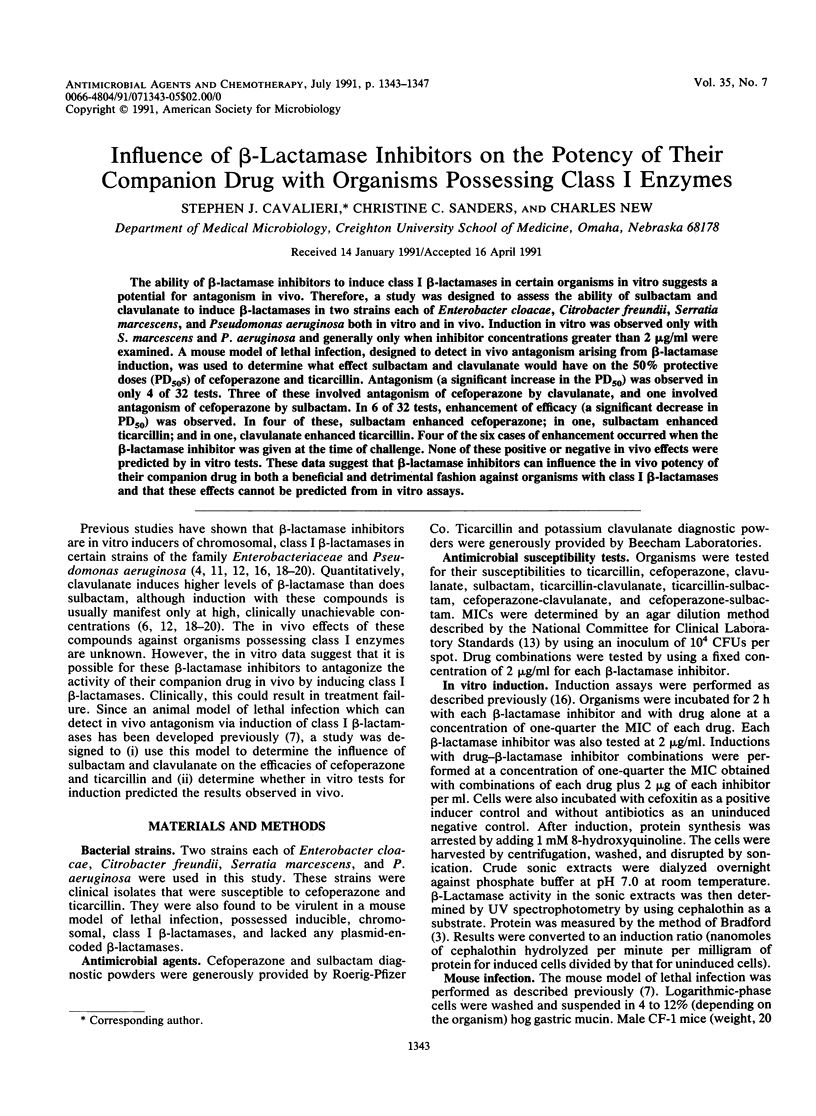
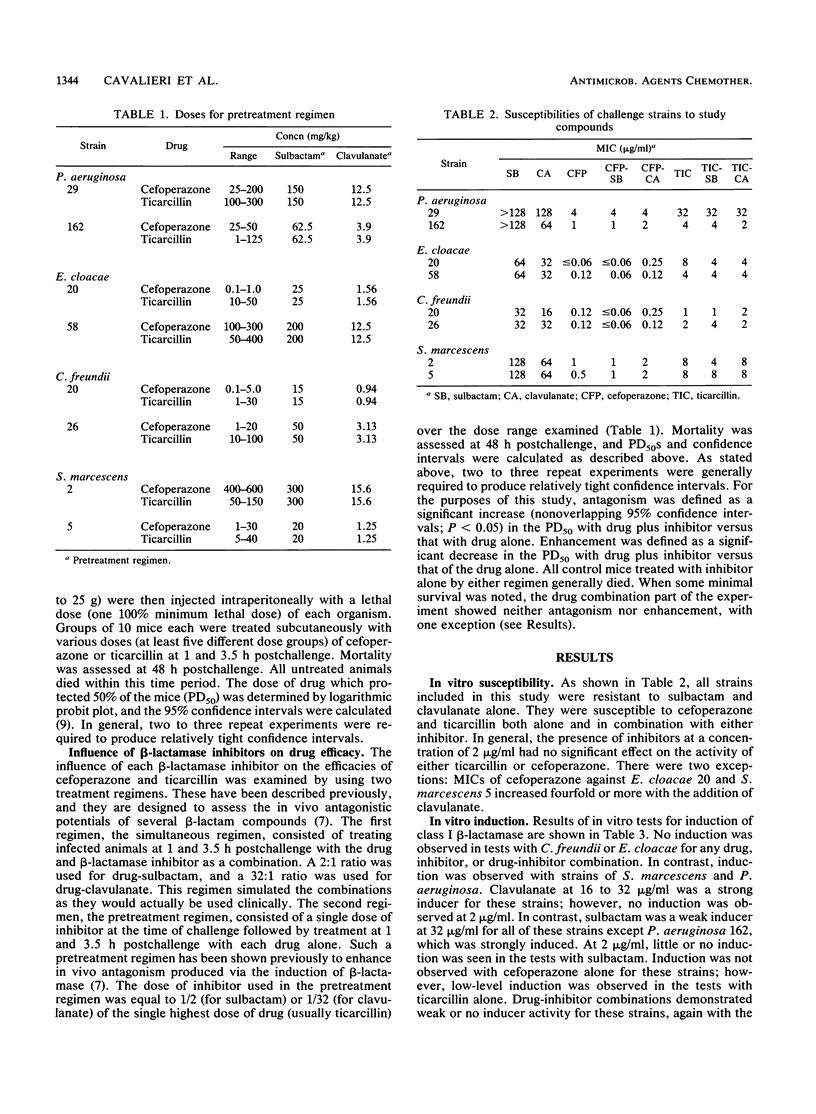
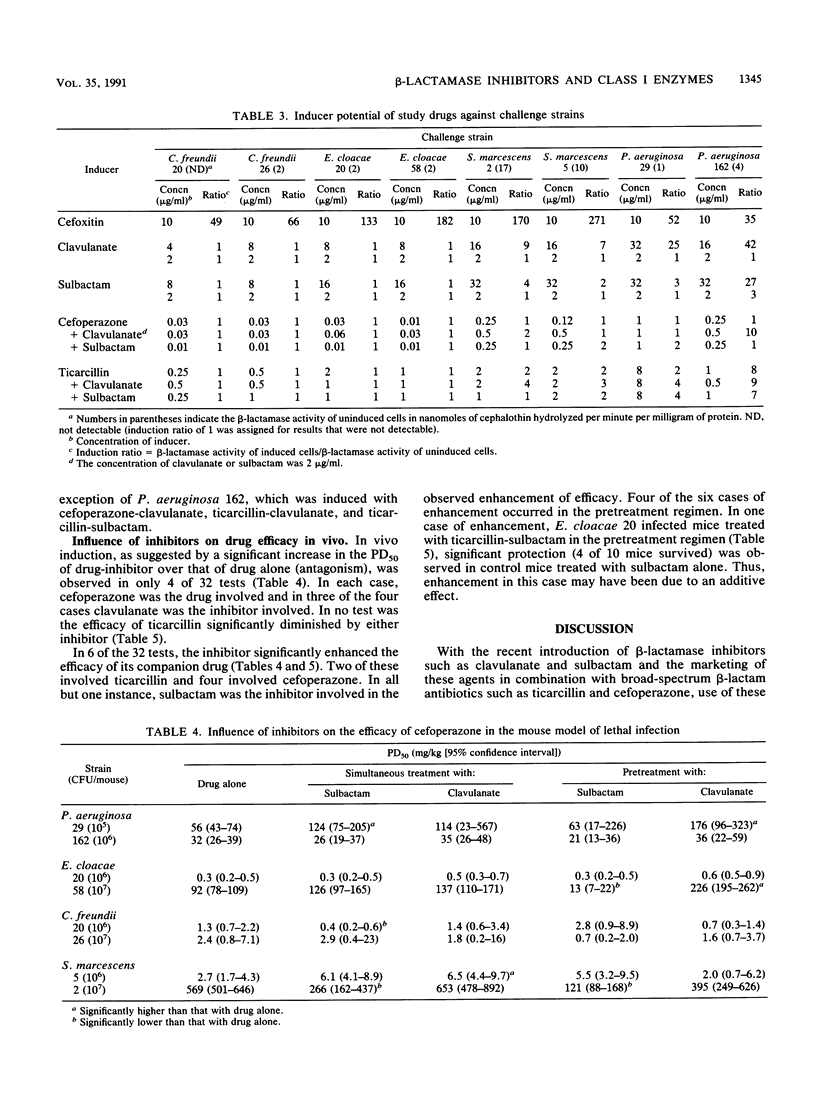
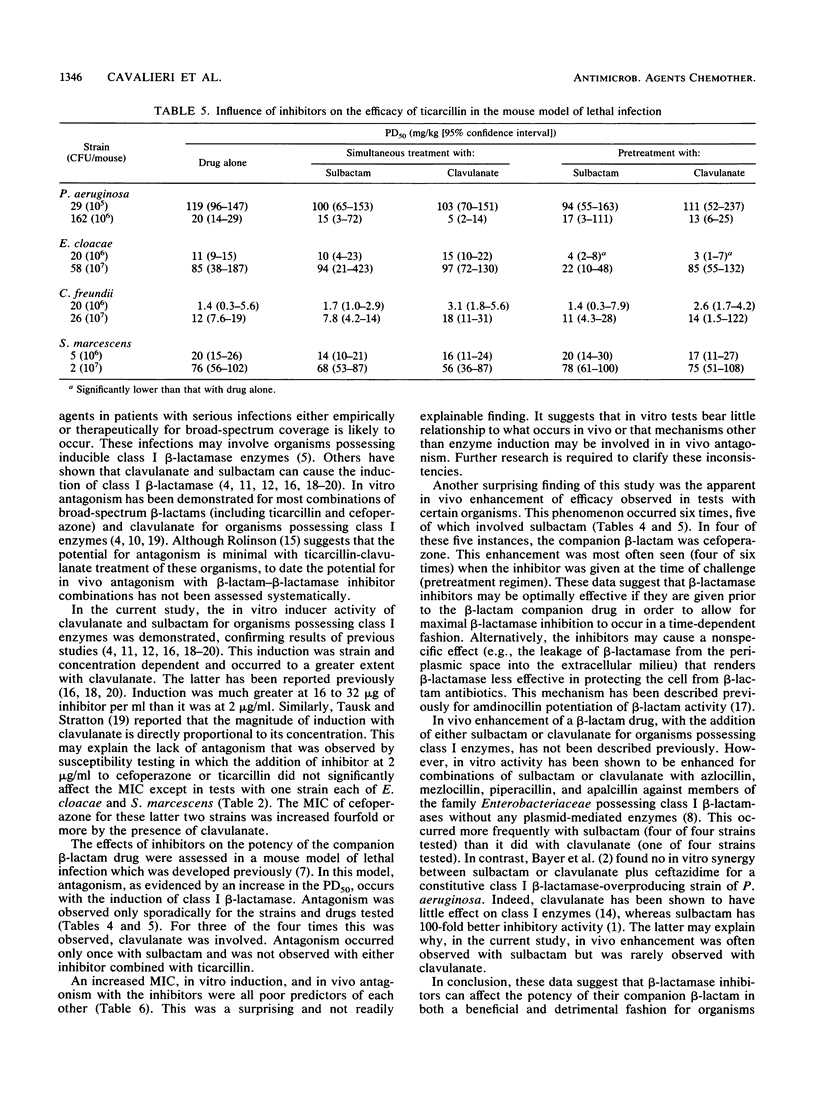
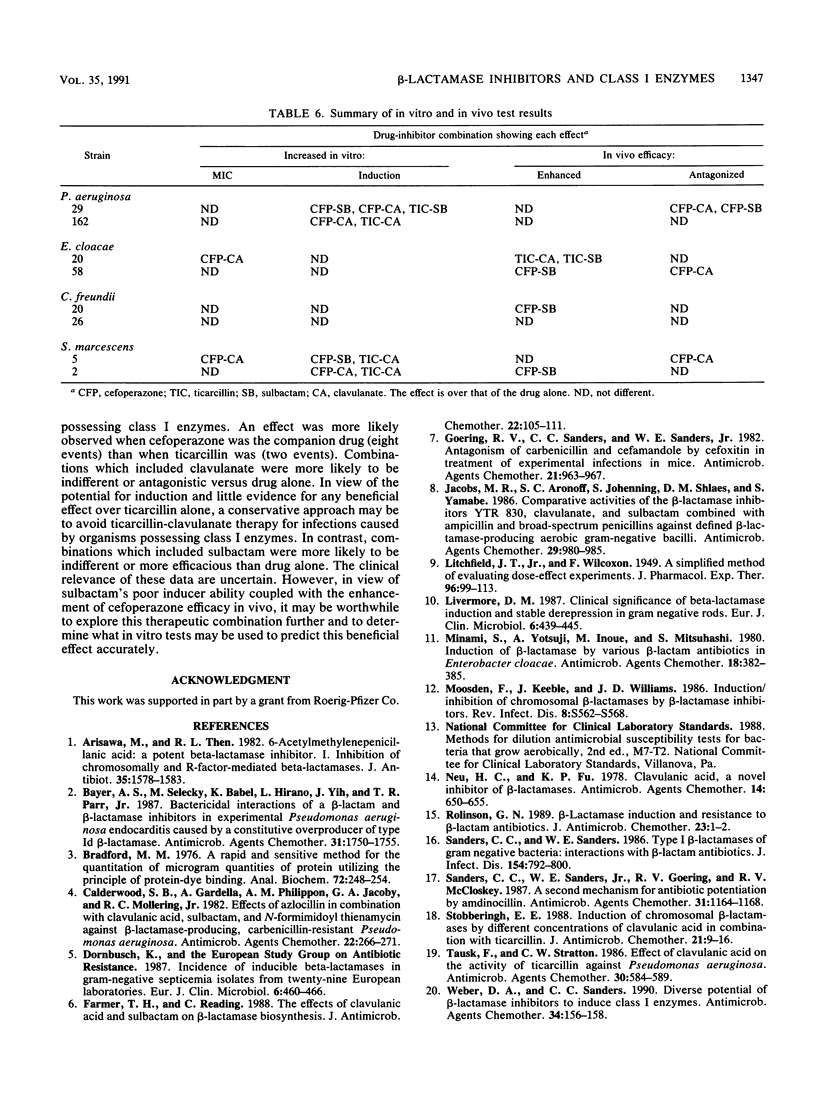
Selected References
These references are in PubMed. This may not be the complete list of references from this article.
- Arisawa M., Then R. L. 6-Acetylmethylenepenicillanic acid (Ro 15-1903), a potent beta-lactamase inhibitor. I. Inhibition of chromosomally and R-factor-mediated beta-lactamases. J Antibiot (Tokyo) 1982 Nov;35(11):1578–1583. doi: 10.7164/antibiotics.35.1578. [DOI] [PubMed] [Google Scholar]
- Bayer A. S., Selecky M., Babel K., Hirano L., Yih J., Parr T. R., Jr Bactericidal interactions of a beta-lactam and beta-lactamase inhibitors in experimental Pseudomonas aeruginosa endocarditis caused by a constitutive overproducer of type Id beta-lactamase. Antimicrob Agents Chemother. 1987 Nov;31(11):1750–1755. doi: 10.1128/aac.31.11.1750. [DOI] [PMC free article] [PubMed] [Google Scholar]
- Bradford M. M. A rapid and sensitive method for the quantitation of microgram quantities of protein utilizing the principle of protein-dye binding. Anal Biochem. 1976 May 7;72:248–254. doi: 10.1016/0003-2697(76)90527-3. [DOI] [PubMed] [Google Scholar]
- Calderwood S. B., Gardella A., Philippon A. M., Jacoby G. A., Moellering R. C., Jr Effects of azlocillin in combination with clavulanic acid, sulbactam, and N-formimidoyl thienamycin against beta-lactamase-producing, carbenicillin-resistant Pseudomonas aeruginosa. Antimicrob Agents Chemother. 1982 Aug;22(2):266–271. doi: 10.1128/aac.22.2.266. [DOI] [PMC free article] [PubMed] [Google Scholar]
- Farmer T. H., Reading C. The effects of clavulanic acid and sulbactam on beta-lactamase biosynthesis. J Antimicrob Chemother. 1988 Aug;22(2):105–111. doi: 10.1093/jac/22.2.105. [DOI] [PubMed] [Google Scholar]
- Goering R. V., Sanders C. C., Sanders W. E., Jr Antagonism of carbenicillin and cefamandole by cefoxitin in treatment of experimental infections in mice. Antimicrob Agents Chemother. 1982 Jun;21(6):963–967. doi: 10.1128/aac.21.6.963. [DOI] [PMC free article] [PubMed] [Google Scholar]
- Jacobs M. R., Aronoff S. C., Johenning S., Shlaes D. M., Yamabe S. Comparative activities of the beta-lactamase inhibitors YTR 830, clavulanate, and sulbactam combined with ampicillin and broad-spectrum penicillins against defined beta-lactamase-producing aerobic gram-negative bacilli. Antimicrob Agents Chemother. 1986 Jun;29(6):980–985. doi: 10.1128/aac.29.6.980. [DOI] [PMC free article] [PubMed] [Google Scholar]
- Livermore D. M. Clinical significance of beta-lactamase induction and stable derepression in gram-negative rods. Eur J Clin Microbiol. 1987 Aug;6(4):439–445. doi: 10.1007/BF02013107. [DOI] [PubMed] [Google Scholar]
- Minami S., Yotsuji A., Inoue M., Mitsuhashi S. Induction of beta-lactamase by various beta-lactam antibiotics in Enterobacter cloacae. Antimicrob Agents Chemother. 1980 Sep;18(3):382–385. doi: 10.1128/aac.18.3.382. [DOI] [PMC free article] [PubMed] [Google Scholar]
- Moosdeen F., Keeble J., Williams J. D. Induction/inhibition of chromosomal beta-lactamases by beta-lactamase inhibitors. Rev Infect Dis. 1986 Nov-Dec;8 (Suppl 5):S562–S568. doi: 10.1093/clinids/8.supplement_5.s562. [DOI] [PubMed] [Google Scholar]
- Neu H. C., Fu K. P. Clavulanic acid, a novel inhibitor of beta-lactamases. Antimicrob Agents Chemother. 1978 Nov;14(5):650–655. doi: 10.1128/aac.14.5.650. [DOI] [PMC free article] [PubMed] [Google Scholar]
- Rolinson G. N. Beta-lactamase induction and resistance to beta-lactam antibiotics. J Antimicrob Chemother. 1989 Jan;23(1):1–2. doi: 10.1093/jac/23.1.1. [DOI] [PubMed] [Google Scholar]
- Sanders C. C., Sanders W. E., Jr, Goering R. V., McCloskey R. V. Leakage of beta-lactamase: a second mechanism for antibiotic potentiation by amdinocillin. Antimicrob Agents Chemother. 1987 Aug;31(8):1164–1168. doi: 10.1128/aac.31.8.1164. [DOI] [PMC free article] [PubMed] [Google Scholar]
- Sanders C. C., Sanders W. E., Jr Type I beta-lactamases of gram-negative bacteria: interactions with beta-lactam antibiotics. J Infect Dis. 1986 Nov;154(5):792–800. doi: 10.1093/infdis/154.5.792. [DOI] [PubMed] [Google Scholar]
- Stobberingh E. E. Induction of chromosomal beta-lactamases by different concentrations of clavulanic acid in combination with ticarcillin. J Antimicrob Chemother. 1988 Jan;21(1):9–16. doi: 10.1093/jac/21.1.9. [DOI] [PubMed] [Google Scholar]
- Tausk F., Stratton C. W. Effect of clavulanic acid on the activity of ticarcillin against Pseudomonas aeruginosa. Antimicrob Agents Chemother. 1986 Oct;30(4):584–589. doi: 10.1128/aac.30.4.584. [DOI] [PMC free article] [PubMed] [Google Scholar]
- Weber D. A., Sanders C. C. Diverse potential of beta-lactamase inhibitors to induce class I enzymes. Antimicrob Agents Chemother. 1990 Jan;34(1):156–158. doi: 10.1128/aac.34.1.156. [DOI] [PMC free article] [PubMed] [Google Scholar]


